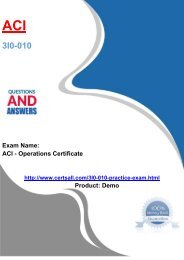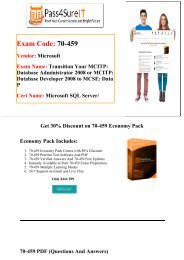Pass4sure Microsoft 70-516CSHARP Exam Questions - 100% success Guaranteed
"pass4sureit provides you a chance to become a certified professional after getting your Microsoft 70-516CSHARP certification. It provides you the most updated question and answers in PDF format for your Microsoft 70-516CSHARP exam preparation. It does'nt provide you lengthy and outdated questions instead it provides you latest learning material and updates it regularly. provides you a comprehensive and customization learning experience by giving you PDF format questions and answers that enables you to pass your Microsoft 70-516CSHARP exam with full confidence and surety. PDF format questions and answers will improvise your knowledge and makes you more literate. After comprehensive study of these questions and answers you can justify your preparation by 70-516CSHARP practice test. There are many sites which provide preparation material but no one takes the responsibility of your result. provides you actual 90 days money back guarantee so don't miss the chance of risk-free investment and get your certification in first attempt. For more details and information please visit the following link http://www.pass4sureit.com/70-516CSHARP-practice-test.html"
"pass4sureit provides you a chance to become a certified professional after getting your Microsoft 70-516CSHARP certification. It provides you the most updated question and answers in PDF format for your Microsoft 70-516CSHARP exam preparation. It does'nt provide you lengthy and outdated questions instead it provides you latest learning material and updates it regularly.
provides you a comprehensive and customization learning experience by giving you PDF format questions and answers that enables you to pass your Microsoft 70-516CSHARP exam with full confidence and surety. PDF format questions and answers will improvise your knowledge and makes you more literate. After comprehensive study of these questions and answers you can justify your preparation by 70-516CSHARP practice test.
There are many sites which provide preparation material but no one takes the responsibility of your result. provides you actual 90 days money back guarantee so don't miss the chance of risk-free investment and get your certification in first attempt. For more details and information please visit the following link http://www.pass4sureit.com/70-516CSHARP-practice-test.html"
Create successful ePaper yourself
Turn your PDF publications into a flip-book with our unique Google optimized e-Paper software.
<strong>Exam</strong> Code: <strong>70</strong><strong>516CSHARP</strong><br />
Vendor: <strong>Microsoft</strong><br />
<strong>Exam</strong> Name: Accessing Data with<br />
<strong>Microsoft</strong> .NET Framework<br />
Cert Name: MCPD/MCPD Web<br />
Developer/<br />
Get 30% Discount on <strong>70</strong><strong>516CSHARP</strong> Economy Pack<br />
Economy Pack Includes:<br />
1. <strong>70</strong><strong>516CSHARP</strong> Economy Pack Comes with 30% Discount<br />
2. <strong>70</strong><strong>516CSHARP</strong> Practice Test Software And PDF<br />
3. <strong>70</strong><strong>516CSHARP</strong> Verified Answers And <strong>70</strong><strong>516CSHARP</strong> Free<br />
Updates<br />
4. Instantly Available to Start <strong>70</strong><strong>516CSHARP</strong> <strong>Exam</strong> Preparation<br />
5. <strong>70</strong><strong>516CSHARP</strong> Multiple Learning Modes<br />
6. 24/7 Support on Email and Live Chat<br />
Only $111 $99<br />
<strong>70</strong><strong>516CSHARP</strong> PDF (<strong>Questions</strong> And Answers)
Format: <strong>70</strong><strong>516CSHARP</strong> PDF<br />
Available for All Devices<br />
<strong>70</strong><strong>516CSHARP</strong> Verified <strong>Questions</strong><br />
<strong>100%</strong> passing guarantee<br />
Only $79 $69<br />
<strong>Microsoft</strong> Certification exams and How to<br />
pass?<br />
Certification exams are usually something made known to a candidate who has assorted their<br />
choice of a career as well as precisely which certification exam is needed for it. Keeping this in<br />
mind, exam preparatory material will be needed to help you pass the <strong>Microsoft</strong> <strong>70</strong><strong>516CSHARP</strong><br />
exam.<br />
<strong>Microsoft</strong> <strong>70</strong><strong>516CSHARP</strong> exam product<br />
We offer exam products that can greatly help you to pass a certification exam; they offer two<br />
major features the • First being a PDF that has all of the questions and answers to the<br />
<strong>Microsoft</strong> <strong>70</strong><strong>516CSHARP</strong> exam • Second is practice software that you can try and test your<br />
skills on!<br />
There are many sites that provide preparation material for <strong>Microsoft</strong> MCPD/MCPD Web<br />
Developer/ <strong>70</strong><strong>516CSHARP</strong> exam. Keep your eyes open and make a gentle decision while<br />
purchasing <strong>Microsoft</strong> <strong>70</strong><strong>516CSHARP</strong> Accessing Data with <strong>Microsoft</strong> .NET Framework exam<br />
product. I am going to tell you the most authentic source for <strong>Microsoft</strong> <strong>70</strong><strong>516CSHARP</strong> exam<br />
preparation.
User friendly interface of <strong>70</strong><strong>516CSHARP</strong> Practice Software<br />
<strong>Pass4sure</strong>Test Practice Software has a user friendly interface that will make it easier for clients<br />
and customers to work with.<br />
Selfassessment feature of <strong>70</strong><strong>516CSHARP</strong><br />
Accessing Data with <strong>Microsoft</strong> .NET<br />
Framework Practice Software<br />
<strong>Pass4sure</strong>Test Practice Software will allow you to see rapid improvement over time as they will<br />
allow you to get better and better as you continue to practice your exam skills. <strong>Microsoft</strong> <strong>70</strong><br />
<strong>516CSHARP</strong> MCPD/MCPD Web Developer/ Certification <strong>Exam</strong>â€s Practice Software has a<br />
selfassessment feature which will allow you to testify and rectify your mistakes with its result.<br />
Customizable learning experience with <strong>Pass4sure</strong>Test<br />
Our <strong>Pass4sure</strong>it offer a highly customizable learning experience as you can vary our products<br />
the exam you wish to try out or the features you need to put to the test.<br />
to<br />
Discount for MCPD/MCPD Web Developer/ <strong>70</strong><strong>516CSHARP</strong><br />
exam product<br />
Our <strong>70</strong><strong>516CSHARP</strong> exam product also offer discounts that range from 30 to 50%.<br />
Money Back Guarantee<br />
We offer refunds within seven days if the exam product is not to your liking or if it<br />
has not satisfactory learning or preparatory material for the <strong>Microsoft</strong> <strong>70</strong><br />
<strong>516CSHARP</strong> Accessing Data with <strong>Microsoft</strong> .NET Framework exam.<br />
Security and Privacy<br />
You can be sure that with our use of McAfee and SSL64, our <strong>70</strong><strong>516CSHARP</strong> exam product has<br />
been absolutely safe for you to use without breach of your safety or personal information at any<br />
cost.
Free demo of <strong>Microsoft</strong> <strong>70</strong><strong>516CSHARP</strong> Practice Software<br />
We offer free demos; this means that you can download and try out our free demos before opting<br />
for the opinion of downloading and buying the entire exam product in question. Download FREE<br />
Demo of <strong>Microsoft</strong> MCPD/MCPD Web Developer/ Certification <strong>Exam</strong>â€s Practice Software<br />
and check itâ€s germane.
<strong>Microsoft</strong><br />
<strong>70</strong>-<strong>516CSHARP</strong><br />
<strong>Exam</strong> Name:<br />
Accessing Data with <strong>Microsoft</strong> .NET Framework<br />
http://www.pass4sureit.com/<strong>70</strong>-<strong>516CSHARP</strong>practice-test.html<br />
Product: Demo
We also offer PRACTICE TEST SOFTWARE with Actual <strong>Exam</strong> <strong>Questions</strong> - Try free demo from our Website<br />
Question: 1<br />
You use <strong>Microsoft</strong> Visual Studio 2010 and <strong>Microsoft</strong> .NET Framework 4 to create an application. The<br />
application contains the following code segment. (Line numbers are included for reference only.)<br />
01 class DataAccessLayer<br />
02 {<br />
03 private static string connString;<br />
04<br />
05 ...<br />
06 public static DataTable GetDataTable(string command){<br />
07<br />
08 ...<br />
09 }<br />
10 }<br />
You need to define the connection life cycle of the DataAccessLayer class. You also need to ensure<br />
that the application uses the minimum number of connections to the database. What should you do?<br />
Insert the following code segment at line 04.<br />
private static SqlConnection conn = new SqlConnection(connString);<br />
public static void Open(){<br />
conn.Open();<br />
}<br />
public static void Close(){<br />
conn.Close();<br />
}<br />
B.Insert the following code segment at line 04.<br />
private SqlConnection conn = new SqlConnection(connString);<br />
public void Open(){<br />
conn.Open(); }<br />
public void Close(){<br />
conn.Close();<br />
}<br />
C.Replace line 01 with the following code segment.<br />
class DataAccessLayer : IDisposable<br />
Insert the following code segment to line 04.<br />
private SqlConnection conn = new SqlConnection(connString);<br />
public void Open(){<br />
conn.Open();<br />
}<br />
public void Dispose(){<br />
conn.Close();<br />
}<br />
D.Insert the following code segment at line 07.<br />
using (SqlConnection conn = new SqlConnection(connString)){<br />
conn.Open();<br />
}<br />
Answer: D<br />
Explanation:<br />
One thing you should always do is to make sure your connections are always opened within a using<br />
statement.<br />
P a g e | 2<br />
P a g e | 2
We also offer PRACTICE TEST SOFTWARE with Actual <strong>Exam</strong> <strong>Questions</strong> - Try free demo from our Website<br />
Using statements will ensure that even if your application raises an exception while the connection is<br />
open, it will always be closed<br />
(returned to the pool) before your request is complete. This is very important, otherwise there could<br />
be connection leaks.<br />
Question: 2<br />
You use <strong>Microsoft</strong> Visual Studio 2010 and <strong>Microsoft</strong> .NET Framework 4 to create a Windows<br />
Communication Foundation (WCF) Data Services service. You discover that when an application<br />
submits a PUT or DELETE request to the Data Services service, it receives an error. You need to ensure<br />
that the application can access the service. Which header and request type should you use in the<br />
application?<br />
A. an X-HTTP-Method header as part of a POST request<br />
B. an X-HTTP-Method header as part of a GET request<br />
C. an HTTP ContentType header as part of a POST request<br />
D. an HTTP ContentType header as part of a GET request<br />
Answer: A<br />
Explanation:<br />
The X-HTTP-Method header can be added to a POST request that signals that the server MUST process<br />
the request not as a POST, but as if the HTTP verb specified as the value of the header was used as the<br />
method on the HTTP request's request line, as specified in [RFC2616] section 5.1. This technique is<br />
often referred to as "verb tunneling". This header is only valid when on HTTP POST requests.<br />
X-HTTPMethod<br />
(http://msdn.microsoft.com/en-us/library/dd541471(v=prot.10).aspx)<br />
Question: 3<br />
You use <strong>Microsoft</strong> Visual Studio 2010 and <strong>Microsoft</strong> .NET Framework 4 to create a Windows<br />
Communication Foundation (WCF) Data Services service. The service connects to a <strong>Microsoft</strong> SQL<br />
Server 2008 database. The service is hosted by an Internet Information Services (IIS) 6.0 Web server.<br />
The application works correctly in the development environment. However, when you connect to the<br />
service on the production server, attempting to update or delete an entity results in an error. You<br />
need to ensure that you can update and delete entities on the production server. What should you<br />
do?<br />
A. Add the following line of code to the InitializeService method of the service.<br />
config.SetEntitySetAccessRule ("*",EntitySetRights.WriteDelete |<br />
EntitySetRights.WriteInsert);<br />
B. Add the following line of code to the InitializeService method of the service.<br />
config.SetEntitySetAccessRule ("*",EntitySetRights.WriteDelete |<br />
EntitySetRights.WriteMerge);<br />
C. Configure IIS to allow the PUT and DELETE verbs for the .svc Application Extension.<br />
D. Configure IIS to allow the POST and DELETE verbs for the .svc Application Extension.<br />
Answer: C<br />
P a g e | 3<br />
P a g e | 3
We also offer PRACTICE TEST SOFTWARE with Actual <strong>Exam</strong> <strong>Questions</strong> - Try free demo from our Website<br />
Explanation:<br />
An OData client accesses data provided by an OData service using standard HTTP. The OData protocol<br />
largely follows the conventions defined by REST, which define how HTTP verbs are used. The most<br />
important of these verbs are:<br />
GET: Reads data from one or more entities.<br />
PUT: Updates an existing entity, replacing all of its properties.<br />
MERGE: Updates an existing entity, but replaces only specified properties[2].<br />
POST: Creates a new entity.<br />
DELETE: Removes an entity.<br />
Http Header Verbs Enumeration<br />
(http://msdn.microsoft.com/en-us/library/windows/desktop/aa364664(v=vs.85).aspx)<br />
WCF Data Services Overview<br />
(http://msdn.microsoft.com/en-us/library/cc668794.aspx)<br />
Introduction to OData Protocol<br />
(http://msdn.microsoft.com/en-us/data/hh237663)<br />
Question: 4<br />
You use <strong>Microsoft</strong> .NET Framework 4 to develop an application that connects to a <strong>Microsoft</strong> SQL Server<br />
2008 database by using SQL Server authentication. The application contains the following connection<br />
string. SERVER=DBSERVER-01; DATABASE=pubs; uid=sa; pwd=secret; You need to ensure that the<br />
password value in the connection string property of a SqlConnection object does not exist after the<br />
Open method is called. What should you add to the connection string?<br />
A. Persist Security Info=True<br />
B. Trusted_Connection=True<br />
C. Persist Security Info=False<br />
D. Trusted_Connection=False<br />
Answer: C<br />
Explanation:<br />
The Persist Security Info property specifies whether the data source can persist sensitive<br />
authentication information such as a password.<br />
Persist Security Info Property<br />
(http://msdn.microsoft.com/en-us/library/aa214039(v=sql.80).aspx)<br />
Question: 5<br />
You use <strong>Microsoft</strong> Visual Studio 2010 and <strong>Microsoft</strong> .NET Framework 4 to create an application. The<br />
application connects to a <strong>Microsoft</strong> SQL Server database. The application uses the ADO.NET Entity<br />
Framework to manage order data. The application makes a Web service call to obtain orders from an<br />
order-tracking system. You need to ensure that the orders are added to the local data store. Which<br />
method should you call on the ObjectContext?<br />
A. Attach<br />
B. AttachTo<br />
C. AddObject<br />
D. ApplyCurrentValues<br />
P a g e | 4<br />
P a g e | 4
We also offer PRACTICE TEST SOFTWARE with Actual <strong>Exam</strong> <strong>Questions</strong> - Try free demo from our Website<br />
Answer: C<br />
Explanation:<br />
ObjectContext.AddObject() Call AddObject on the ObjectContext to add the object to the object<br />
context.<br />
Do this when the object is a new object that does not yet exist in the data source.<br />
ObjectContext.Attach() Call Attach on the ObjectContext to attach the object to the object context.<br />
Do this when the object already exists in the data source but is currently not attached to the context.<br />
If the object being attached has related objects, those objects will also be attached to the object<br />
context.<br />
Objects are added to the object context in an unchanged state.<br />
The object that is passed to the Attach method must have a valid EntityKey value.<br />
If the object does not have a valid EntityKey value, use the AttachTo method to specify the name of<br />
the entity set.<br />
ObjectContext.AttachTo() Call AttachTo on the ObjectContext to attach the object to a specific entity<br />
set in the object context or if the object has a null (Nothing in Visual Basic) EntityKey value.<br />
The object being attached is not required to have an EntityKey associated with it. If the object does<br />
not have an entity key, then entitySetName cannot be an empty string.<br />
ApplyCurrentValues() method is used to apply changes that were made to objects outside<br />
the ObjectContext, such as detached objects that are received by a Web service.<br />
The method copies the scalar values from the supplied object into the object in the ObjectContext<br />
that has the same key.<br />
You can use the EntityKey of the detached object to retrieve an instance of this object from the data<br />
source.<br />
Question: 6<br />
You use <strong>Microsoft</strong> Visual Studio 2010 and <strong>Microsoft</strong> .NET Framework 4 to create an application. The<br />
application connects to a <strong>Microsoft</strong> SQL Server database. The application uses the ADO.NET Entity<br />
Framework to model entities. The database includes objects based on the exhibit. (Click the Exhibit<br />
button.)<br />
P a g e | 5<br />
P a g e | 5
We also offer PRACTICE TEST SOFTWARE with Actual <strong>Exam</strong> <strong>Questions</strong> - Try free demo from our Website<br />
The application includes the following code segment. (Line numbers are included for reference only.)<br />
01 using (AdventureWorksEntities advWorksContext = new AdventureWorksEntities()){<br />
02<br />
03 }<br />
You need to retrieve a list of all Products from todays sales orders for a specified customer. You also<br />
need to ensure that the application uses the minimum amount of memory when retrieving the list.<br />
Which code segment should you insert at line 02?<br />
A. Contact customer = context.Contact.Where("it.ContactID =<br />
@customerId", new ObjectParameter("customerId", customerId)).First();<br />
customer.SalesOrderHeader.Load();<br />
foreach (SalesOrderHeader order in customer.SalesOrderHeader)<br />
{<br />
order.SalesOrderDetail.Load();<br />
if (order.OrderDate.Date == DateTime.Today.Date)<br />
{<br />
foreach (SalesOrderDetail item in order.SalesOrderDetail)<br />
{<br />
Console.WriteLine(String.Format("Product: {0} ", item.ProductID));<br />
}<br />
}<br />
}<br />
B.Contact customer = context.Contact.Where("it.ContactID =<br />
@customerId", new ObjectParameter("customerId", customerId)).First();<br />
customer.SalesOrderHeader.Load();<br />
foreach (SalesOrderHeader order in customer.SalesOrderHeader){<br />
if (order.OrderDate.Date == DateTime.Today.Date)<br />
{<br />
order.SalesOrderDetail.Load();<br />
foreach (SalesOrderDetail item in order.SalesOrderDetail)<br />
{<br />
Console.WriteLine(String.Format("Product: {0} ", item.ProductID));<br />
}<br />
}<br />
}<br />
C.Contact customer = (from contact in context.Contact.Include("SalesOrderHeader")<br />
select contact).FirstOrDefault();<br />
foreach (SalesOrderHeader order in customer.SalesOrderHeader)<br />
{<br />
order.SalesOrderDetail.Load();<br />
if (order.OrderDate.Date == DateTime.Today.Date){<br />
foreach (SalesOrderDetail item in order.SalesOrderDetail)<br />
{<br />
Console.WriteLine(String.Format("Product: {0} ", item.ProductID));<br />
}<br />
}<br />
}<br />
D.Contact customer = (from contact in<br />
context.Contact.Include("SalesOrderHeader.SalesOrderDetail")<br />
select contact).FirstOrDefault();<br />
foreach (SalesOrderHeader order in customer.SalesOrderHeader)<br />
{<br />
if (order.OrderDate.Date == DateTime.Today.Date)<br />
{<br />
foreach (SalesOrderDetail item in order.SalesOrderDetail)<br />
P a g e | 6<br />
P a g e | 6
We also offer PRACTICE TEST SOFTWARE with Actual <strong>Exam</strong> <strong>Questions</strong> - Try free demo from our Website<br />
{<br />
Console.WriteLine(String.Format("Product: {0} ", item.ProductID));<br />
}<br />
}<br />
}<br />
Answer: B<br />
Explanation:<br />
A & C check the Order date after Order Detail, so we are retrieving more Order details than necessary<br />
D is calling a Function (using eager loading) for the First Contact record only, so does not meet the<br />
requirements.<br />
Question: 7<br />
You use <strong>Microsoft</strong> Visual Studio 2010 and <strong>Microsoft</strong> .NET Framework 4 to create a <strong>Microsoft</strong> ASP.NET<br />
application. You want to connect the application to a <strong>Microsoft</strong> SQL Server Express 2008 database<br />
named MyDatabase. The primary database file is named MyDatabase.mdf and it is stored in the<br />
App_Data folder. You need to define the connection string. Which connection string should you add<br />
to the Web.config file?<br />
A. Data Source=localhost; Initial Catalog=MyDataBase; Integrated Security=SSPI; User Instance=True<br />
B. Data Source=.\SQLEXPRESS; Initial Catalog=MyDataBase; Integrated Security=True; User<br />
Instance=True<br />
C. Data Source=.\SQLEXPRESS; AttachDbFilename=|DataDirectory|\MyDatabase.mdf; Integrated<br />
Security=True; User Instance=True<br />
D. Data Source=SQLEXPRESS; AttachDbFilename=|DataDirectory|\App_Data\MyDatabase.mdf;<br />
Integrated Security=SSPI; User Instance=True<br />
Answer: C<br />
Explanation:<br />
CHAPTER 2 ADO.NET Connected Classes<br />
Lesson 1: Connecting to the Data Store<br />
Attaching to a Local SQL Database File with SQL Express (page 73)<br />
Question: 8<br />
You use <strong>Microsoft</strong> Visual Studio 2010 and <strong>Microsoft</strong> .NET Framework 4 to create an application. You<br />
use the ADO.NET Entity Framework to model entities. You write the following code segment. (Line<br />
numbers are included for reference only.)<br />
01 AdventureWorks Entities context = new AdventureWorksEntities (<br />
02 " http://localhost:1234/AdventureWorks.svc "<br />
03 );<br />
04<br />
05 var q = from c in context.Customers<br />
06 where c.City == "London"<br />
07 orderby c.CompanyName<br />
08 select c;<br />
P a g e | 7<br />
P a g e | 7
We also offer PRACTICE TEST SOFTWARE with Actual <strong>Exam</strong> <strong>Questions</strong> - Try free demo from our Website<br />
You need to ensure that the application meets the following requirements:<br />
• Compares the current values of unmodified properties with values returned from the data source.<br />
• Marks the property as modified when the properties are not the same<br />
Which code segment should you insert at line 04?<br />
A. context.MergeOption = MergeOption.AppendOnly;<br />
B. context.MergeOption = MergeOption.PreserveChanges;<br />
C. context.MergeOption = MergeOption.OverwriteChanges;<br />
D. context.MergeOption = MergeOption.NoTracking;<br />
Answer: B<br />
Explanation:<br />
PreserveChanges - Objects that do not exist in the object context are attached to the context.<br />
If the state of the entity is Unchanged, the current and original values in the entry are overwritten<br />
with data source values.<br />
The state of the entity remains Unchanged and no properties are marked as modified.<br />
If the state of the entity is Modified, the current values of modified properties are not overwritten<br />
with data source values.<br />
The original values of unmodified properties are overwritten with the values from the data source.<br />
In the .NET Framework version 4, the Entity Framework compares the current values of unmodified<br />
properties with the values that were returned from the data source. If the values are not the same,<br />
the property is marked as modified.<br />
MergeOption Enumeration<br />
(http://msdn.microsoft.com/en-us/library/system.data.objects.mergeoption.aspx)<br />
Question: 9<br />
You use <strong>Microsoft</strong> .NET Framework 4 to develop an application. The configuration file contains the<br />
following code segment.<br />
<br />
<br />
<br />
<br />
<br />
You need to retrieve the connection string named AdventureWorksLT from the configuration file.<br />
Which line of code should you use?<br />
A. var connectionString =<br />
ConfigurationManager .ConnectionStrings["AdventureWorksLT"].ConnectionString;<br />
B.var connectionString = ConfigurationManager<br />
.ConnectionStrings["AdventureWorksLT"].Name;<br />
C.var connectionString = ConfigurationManager<br />
.AppSettings["AdventureWorksLT"];<br />
D.var connectionString = ConfigurationSettings<br />
.AppSettings["AdventureWorksLT"];<br />
P a g e | 8<br />
P a g e | 8
We also offer PRACTICE TEST SOFTWARE with Actual <strong>Exam</strong> <strong>Questions</strong> - Try free demo from our Website<br />
Answer: A<br />
Question: 10<br />
You use <strong>Microsoft</strong> Visual Studio 2010 and <strong>Microsoft</strong> .NET Framework 4 to develop an application that<br />
connects to a <strong>Microsoft</strong> SQL Server 2008 database. The application includes a SqlConnection named<br />
conn and a SqlCommand named cmd. You need to create a transaction so that database changes will<br />
be reverted in the event that an exception is thrown. Which code segment should you use?<br />
A. var transaction = conn.BeginTransaction();<br />
cmd.Transaction = transaction;<br />
try<br />
{<br />
…<br />
transaction.Commit();<br />
}<br />
catch<br />
{<br />
transaction.Rollback();<br />
}<br />
B.var transaction = conn.BeginTransaction();<br />
cmd.Transaction = transaction;<br />
try<br />
{<br />
…<br />
transaction.Commit();<br />
}<br />
catch<br />
{<br />
transaction.Dispose();<br />
}<br />
C.var transaction = conn.BeginTransaction();<br />
cmd.Transaction = transaction;<br />
try<br />
{<br />
…<br />
}<br />
catch<br />
{<br />
transaction.Commit();<br />
}<br />
D.var transaction = conn.BeginTransaction();<br />
cmd.Transaction = transaction;<br />
try<br />
{<br />
…<br />
transaction.Rollback();<br />
}<br />
catch<br />
{<br />
transaction.Dispose ();<br />
}<br />
P a g e | 9<br />
P a g e | 9
We also offer PRACTICE TEST SOFTWARE with Actual <strong>Exam</strong> <strong>Questions</strong> - Try free demo from our Website<br />
Answer: A<br />
Question: 11<br />
You use <strong>Microsoft</strong> Visual Studio 2010 and <strong>Microsoft</strong> .NET Framework 4 to create an application. The<br />
application connects to a <strong>Microsoft</strong> SQL Server database and contains a LINQ to SQL data model. The<br />
data model contains a function named createCustomer that calls a stored procedure. The stored<br />
procedure is also named createCustomer. The createCustomer function has the following signature.<br />
createCustomer (Guid customerID, String customerName, String address1)<br />
The application contains the following code segment. (Line numbers are included for reference only.)<br />
01 CustomDataContext context = new CustomDataContext();<br />
02 Guid userID = Guid.NewGuid();<br />
03 String address1 = "1 Main Steet";<br />
04 String name = "Marc";<br />
05<br />
You need to use the createCustomer stored procedure to add a customer to the database. Which code<br />
segment should you insert at line 05?<br />
A. context.createCustomer(userID, name , address1)<br />
B. context.ExecuteCommand("createCustomer", userID, name , address1);<br />
C. Customer customer = new Customer() {<br />
ID = userID,<br />
Address1 = address1,<br />
Name = name,<br />
};<br />
context.ExecuteCommand("createCustomer", customer);<br />
D. Customer customer = new Customer() {<br />
ID = userID,<br />
Address1 = address1,<br />
Name = name,<br />
};<br />
context.ExecuteQuery(typeof(Customer), "createCustomer", customer);<br />
Answer: A<br />
Explanation:<br />
CHAPTER 4 LINQ to SQL<br />
Lesson 3: Submitting Changes to the Database<br />
Using Stored Procedures (page 285)<br />
Question: 12<br />
You use <strong>Microsoft</strong> Visual Studio 2010 and <strong>Microsoft</strong> .NET Framework 4 to create an application. You<br />
use a TableAdapter object to load a DataTable object. The DataTable object is used as the data source<br />
for a GridView control to display a table of customer information on a Web page. You need to ensure<br />
that the application meets the following requirements:<br />
• Load only new customer records each time the page refreshes.<br />
• Preserve existing customer records.<br />
P a g e | 10<br />
P a g e | 10
We also offer PRACTICE TEST SOFTWARE with Actual <strong>Exam</strong> <strong>Questions</strong> - Try free demo from our Website<br />
What should you do?<br />
A. Set the ClearBeforeFill property of the TableAdapter to false.<br />
Use the Fill method of the TableAdapter to load additional customers.<br />
B. Set the ClearBeforeFill property of the TableAdapter to false.<br />
Use the GetData method of the TableAdapter to create a new DataTable.<br />
C. Set the ClearBeforeFill property of the TableAdapter to true.<br />
Use the Fill method of the TableAdapter to load additional customers.<br />
D. Set the ClearBeforeFill property of the TableAdapter to true.<br />
Use the GetData method of the TableAdapter to create a new DataTable.<br />
Answer: A<br />
Explanation:<br />
TableAdapter.Fill Populates the TableAdapter's associated data table with the results of the<br />
TableAdapter's SELECT command.<br />
TableAdapter.Update Sends changes back to the database. For more information, see How to:<br />
Update Data Using a TableAdapter.<br />
TableAdapter.GetData Returns a new DataTable filled with data.<br />
TableAdapter.Insert Creates a new row in the data table. For more information, see How to: Add Rows<br />
to a DataTable.<br />
TableAdapter.ClearBeforeFill Determines whether a data table is emptied before you call one of the<br />
Fill methods.<br />
Table Adapter Overview<br />
(http://msdn.microsoft.com/en-us/library/bz9tthwx(v=vs.80).aspx)<br />
Question: 13<br />
You use <strong>Microsoft</strong> Visual Studio 2010 and <strong>Microsoft</strong> .NET Framework 4 to develop an application that<br />
connects to a <strong>Microsoft</strong> SQL Server 2008 database. The application performs a database query within<br />
a transaction. You need to ensure that the application can read data that has not yet been committed<br />
by other transactions. Which IsolationLevel should you use?<br />
A. ReadUncommitted<br />
B. ReadCommitted<br />
C. RepeatableRead<br />
D. Unspecified<br />
Answer: A<br />
Explanation:<br />
Unspecified A different isolation level than the one specified is being used, but the level cannot be<br />
determined.<br />
When using OdbcTransaction, if you do not set IsolationLevel or you set IsolationLevel to<br />
Unspecified, the transaction executes according to the isolation level that is determined by the driver<br />
that is being used.<br />
Chaos The pending changes from more highly isolated transactions cannot be overwritten.<br />
ReadUncommitted A dirty read is possible, meaning that no shared locks are issued and no exclusive<br />
locks are honored.<br />
P a g e | 11<br />
P a g e | 11
We also offer PRACTICE TEST SOFTWARE with Actual <strong>Exam</strong> <strong>Questions</strong> - Try free demo from our Website<br />
ReadCommitted Shared locks are held while the data is being read to avoid dirty reads, but the data<br />
can be changed before the end of the transaction, resulting in non-repeatable reads or phantom data.<br />
RepeatableRead Locks are placed on all data that is used in a query, preventing other users from<br />
updating the data.<br />
Prevents non-repeatable reads but phantom rows are still possible.<br />
Serializable A range lock is placed on the DataSet, preventing other users from updating or inserting<br />
rows into the dataset until the transaction is complete.<br />
Snapshot Reduces blocking by storing a version of data that one application can read while another is<br />
modifying the same data.<br />
Indicates that from one transaction you cannot see changes made in other transactions, even if you<br />
requery.<br />
IsolationLevel Enumeration<br />
(http://msdn.microsoft.com/en-us/library/system.data.isolationlevel.aspx)<br />
Isolation Levels in Database Engine<br />
(http://msdn.microsoft.com/en-us/library/ms189122.aspx)<br />
SET TRANSACTION ISOLATION LEVEL (Transact-SQL)<br />
(http://msdn.microsoft.com/ru-ru/library/ms173763.aspx)<br />
Question: 14<br />
You use <strong>Microsoft</strong> Visual Studio 2010 and <strong>Microsoft</strong> .NET Framework 4 to create an application. You<br />
create a stored procedure to insert a new record in the Categories table according to following code<br />
segment.<br />
CREATE PROCEDURE dbo.InsertCategory<br />
@CategoryName nvarchar(15),<br />
@Identity int OUT<br />
AS<br />
INSERT INTO Categories (CategoryName) VALUES(@CategoryName)<br />
SET @Identity = SCOPE_IDENTITY()<br />
RETURN @@ROWCOUNT<br />
You write the following code segment. (Line numbers are included for reference only).<br />
01 private static void ReturnIdentity(string connectionString)<br />
02 {<br />
03 using (SqlConnection connection = new SqlConnection(connectionString))<br />
04 {<br />
05 SqlDataAdapter adapter = new SqlDataAdapter(<br />
06 "SELECT CategoryID, CategoryName FROM dbo.Categories",connection);<br />
07 adapter.InsertCommand = new SqlCommand("InsertCategory", connection);<br />
08 adapter.InsertCommand.CommandType = CommandType.StoredProcedure;<br />
09 SqlParameter rowcountParameter = adapter.InsertCommand.Parameters.Add(<br />
10 "@RowCount", SqlDbType.Int);<br />
11<br />
12 adapter.InsertCommand.Parameters.Add(<br />
13 "@CategoryName", SqlDbType.NChar, 15, "CategoryName");<br />
14 SqlParameter identityParameter = adapter.InsertCommand.Parameters.Add(<br />
15 "@Identity", SqlDbType.Int, 0, "CategoryID");<br />
16<br />
17 DataTable categories = new DataTable();<br />
18 adapter.Fill(categories);<br />
19 DataRow categoryRow = categories.NewRow();<br />
20 categoryRow["CategoryName"] = "New Beverages";<br />
21 categories.Rows.Add(categoryRow);<br />
22 adapter.Update(categories);<br />
23 Int32 rowCount = (Int32)adapter.InsertCommand.Parameters["@RowCount"].Value;<br />
P a g e | 12<br />
P a g e | 12
We also offer PRACTICE TEST SOFTWARE with Actual <strong>Exam</strong> <strong>Questions</strong> - Try free demo from our Website<br />
24 }<br />
25 }<br />
You need to retrieve the identity of the new record. You also need to retrieve the row count. What<br />
should you do?<br />
A. Insert the following code segment at line 11.<br />
rowcountParameter.Direction = ParameterDirection.ReturnValue;<br />
Insert the following code segment at line 16.<br />
identityParameter.Direction = ParameterDirection.ReturnValue;<br />
B. Insert the following code segment at line 11.<br />
rowcountParameter.Direction = ParameterDirection.Output;<br />
Insert the following code segment at line 16.<br />
identityParameter.Direction = ParameterDirection.Output;<br />
C. Insert the following code segment at line 11.<br />
rowcountParameter.Direction = ParameterDirection.ReturnValue;<br />
Insert the following code segment at line 16.<br />
identityParameter.Direction = ParameterDirection.Output;<br />
D. Insert the following code segment at line 11.<br />
rowcountParameter.Direction = ParameterDirection.Output;<br />
Insert the following code segment at line 16.<br />
identityParameter.Direction = ParameterDirection.ReturnValue;<br />
Answer: C<br />
Explanation:<br />
Input - The parameter is an input parameter.<br />
InputOutput - The parameter is capable of both input and output.<br />
Output - The parameter is an output parameter.<br />
ReturnValue - The parameter represents a return value from an operation such as a stored procedure,<br />
builtin function, or user-defined function.<br />
ParameterDirection Enumeration<br />
(http://msdn.microsoft.com/en-us/library/system.data.parameterdirection(v=vs.71).aspx)<br />
Question: 15<br />
You use <strong>Microsoft</strong> Visual Studio 2010 and <strong>Microsoft</strong> .NET Framework 4 to develop an application. You<br />
use the ADO.NET Entity Framework Designer to model entities. The application includes self-tracking<br />
entities as shown in the following diagram.<br />
There is a Person entity named person1 that has Track Changes turned on. You need to delete all e-<br />
mail addresses that are associated with person1 by using an ObjectContext named context. What are<br />
P a g e | 13<br />
P a g e | 13
We also offer PRACTICE TEST SOFTWARE with Actual <strong>Exam</strong> <strong>Questions</strong> - Try free demo from our Website<br />
two possible code segments that you can use to achieve this goal? (Each correct answer presents a<br />
complete solution. Choose two).<br />
A. foreach(var email in person1.EmailAddresses)<br />
{<br />
email.MarkAsDeleted();<br />
}<br />
context.SaveChanges();<br />
B. while(person1.EmailAddresses.Count() > 0)<br />
{<br />
person1.EmailAddresses.RemoveAt(0);<br />
}<br />
context.SaveChanges();<br />
C. person1.EmailAddresses = null;<br />
context.SaveChanges();<br />
D. person1.EmailAddresses = new<br />
TrackableCollection();<br />
context.SaveChanges();<br />
Answer: B, C<br />
Explanation:<br />
Working with Self-Tracking Entities<br />
(http://msdn.microsoft.com/en-us/library/ff40<strong>70</strong>90.aspx)<br />
Working with Sets of Self-Tracking Entities<br />
(http://blogs.msdn.com/b/adonet/archive/2010/06/02/working-with-sets-of-self-trackingentities.aspx)<br />
Question: 16<br />
You use <strong>Microsoft</strong> Visual Studio 2010 and <strong>Microsoft</strong> .NET Framework 4 to create an application. The<br />
application uses the ADO.NET Entity Framework to manage customer and related order records. You<br />
add a new order for an existing customer. You need to associate the Order entity with the Customer<br />
entity. What should you do?<br />
A. Set the Value property of the EntityReference of the Order entity.<br />
B. Call the Add method on the EntityCollection of the Order entity.<br />
C. Use the AddObject method of the ObjectContext to add both Order and Customer entities.<br />
D. Use the Attach method of the ObjectContext to add both Order and Customer entities.<br />
Answer: A<br />
Explanation:<br />
Entity Reference (Of Entity) Represents a related end of an association with a multiplicity of zero or<br />
one.<br />
Question: 17<br />
P a g e | 14<br />
P a g e | 14
We also offer PRACTICE TEST SOFTWARE with Actual <strong>Exam</strong> <strong>Questions</strong> - Try free demo from our Website<br />
You use <strong>Microsoft</strong> .NET Framework 4 to develop an application that uses the Entity Framework. The<br />
application has an entity model with a Person entity. A Person instance named person1 and an<br />
ObjectContext instance named model exist. You need to delete the person1 instance. Which code<br />
segment should you use?<br />
A. model.DeleteObject(person1);<br />
model.SaveChanges();<br />
B.model.Detach(person1);<br />
model.SaveChanges();<br />
C.model.ExecuteStoreCommand("Delete", new []<br />
{ new ObjectParameter("Person", person1) });<br />
model.SaveChanges();<br />
D.model.ExecuteFunction("Detach", new []<br />
{ new ObjectParameter("Person", person1) });<br />
model.SaveChanges();<br />
Answer: A<br />
Explanation:<br />
ObjectContext.DeleteObject Marks an object for deletion from the ObjectStateManager. The object is<br />
deleted in the data source when the SaveChanges method is called.<br />
ObjectContext.ExecuteStoreCommand Method executes an arbitrary command directly against the<br />
data source using the existing connection.<br />
Question: 18<br />
You use <strong>Microsoft</strong> Visual Studio 2010 and <strong>Microsoft</strong> .NET Framework 4 to create an application. The<br />
application connects to a <strong>Microsoft</strong> SQL Server database. You use the ADO.NET Entity Framework to<br />
manage persistence-ignorant entities. You create an ObjectContext instance named context. Then,<br />
you directly modify properties on several entities. You need to save the modified entity values to the<br />
database. Which code segment should you use?<br />
A. context.SaveChanges(SaveOptions.AcceptAllChangesAfterSave);<br />
B. context.SaveChanges(SaveOptions.DetectChangesBeforeSave);<br />
C. context.SaveChanges(SaveOptions.None);<br />
D. context.SaveChanges();<br />
Answer: B<br />
Explanation:<br />
None Changes are saved without the DetectChanges or the<br />
AcceptAllChangesAfterSave() methods being called.<br />
AcceptAllChangesAfterSave After changes are saved, the AcceptAllChangesAfterSave() method is<br />
called, which resets change tracking in the ObjectStateManager.<br />
DetectChangesBeforeSave Before changes are saved, the DetectChanges method is called to<br />
synchronize the property values of objects that are attached to the object context with data in the<br />
ObjectStateManager.<br />
SaveOptions Enumeration<br />
(http://msdn.microsoft.com/en-us/library/system.data.objects.saveoptions.aspx)<br />
P a g e | 15<br />
P a g e | 15
We also offer PRACTICE TEST SOFTWARE with Actual <strong>Exam</strong> <strong>Questions</strong> - Try free demo from our Website<br />
Question: 19<br />
You use <strong>Microsoft</strong> Visual Studio 2010 and <strong>Microsoft</strong> .NET Framework 4 to create an application. The<br />
application connects to a <strong>Microsoft</strong> SQL Server database. The application has two DataTable objects<br />
that reference the Customers and Orders tables in the database. The application contains the<br />
following code segment. (Line numbers are included for reference only.)<br />
01 DataSet customerOrders = new DataSet();<br />
02 customerOrders.EnforceConstraints = true;<br />
03 ForeignKeyConstraint ordersFK = new ForeignKeyConstraint("ordersFK",<br />
04 customerOrders.Tables["Customers"].Columns["CustomerID"],<br />
05 customerOrders.Tables["Orders"].Columns["CustomerID"]);<br />
06<br />
07 customerOrders.Tables["Orders"].Constraints.Add(ordersFK);<br />
You need to ensure that an exception is thrown when you attempt to delete Customer records that<br />
have related Order records. Which code segment should you insert at line 06?<br />
A. ordersFK.DeleteRule = Rule.SetDefault;<br />
B. ordersFK.DeleteRule = Rule.None;<br />
C. ordersFK.DeleteRule = Rule.SetNull;<br />
D. ordersFK.DeleteRule = Rule.Cascade;<br />
Answer: B<br />
Explanation:<br />
None No action taken on related rows, but exceptions are generated.<br />
Cascade Delete or update related rows. This is the default.<br />
SetNull Set values in related rows to DBNull.<br />
SetDefault Set values in related rows to the value contained in the DefaultValue property.<br />
SetDefault specifies that all child column values be set to the default value.<br />
CHAPTER 1 ADO.NET Disconnected Classes<br />
Lesson 1: Working with the DataTable and DataSet Classes<br />
Cascading Deletes and Cascading Updates (page 26)<br />
Question: 20<br />
You use <strong>Microsoft</strong> Visual Studio 2010 and <strong>Microsoft</strong> .NET Framework 4 to create an application. The<br />
application connects to a <strong>Microsoft</strong> SQL Server 2008 database. The application uses DataContexts to<br />
query the database. You create a function that meets the following requirements:<br />
• Updates the Customer table on the database when a customer is marked as deleted. • Updates the<br />
related entries in other tables (CustomerAddress, CustomerContacts) by marking them as deleted.<br />
• Prevents consumer code from setting the Deleted columns value directly.<br />
You need to ensure that the function verifies that customers have no outstanding orders before they<br />
are marked as deleted. You also need to ensure that existing applications can use the updated function<br />
without requiring changes in the code. What should you do?<br />
A. Override the Delete operation of the DataContext object.<br />
B. Override the Update operation of the DataContext object.<br />
C. Modify the SELECT SQL statement provided to the DataContext object to use an INNER JOIN<br />
between the Customer and Orders tables.<br />
P a g e | 16<br />
P a g e | 16
We also offer PRACTICE TEST SOFTWARE with Actual <strong>Exam</strong> <strong>Questions</strong> - Try free demo from our Website<br />
D. Add new entities to the DataContext object for the Customers and Orders tables.<br />
Answer: A<br />
P a g e | 17<br />
P a g e | 17
We also offer PRACTICE TEST SOFTWARE with Actual <strong>Exam</strong> <strong>Questions</strong> - Try free demo from our Website<br />
THANKS FOR TRYING THE DEMO OF OUR PRODUCT<br />
Visit Our Site to Purchase the Full Set of Actual <strong>70</strong>-<strong>516CSHARP</strong> <strong>Exam</strong> <strong>Questions</strong> with<br />
Answers.<br />
http://www.pass4sureit.com/<strong>70</strong>-<strong>516CSHARP</strong>-practice-test.html<br />
We Also Provide Practice <strong>Exam</strong> Software That Simulates Real <strong>Exam</strong> Environment And Has<br />
Many Self-Assessment Features. Download Free Product Demo From Our Web Site:<br />
Money Back Guarantee<br />
http://www.pass4sureit.com/<strong>70</strong>-<strong>516CSHARP</strong>-practice-test.html<br />
P a g e | 18<br />
P a g e | 18
















